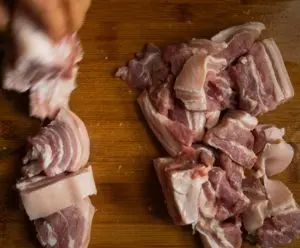
Marcus Gavius Apicius, a first century nobelman in Rome, wrote one of the first known recipes for curing meat. He instructed that the salt should be added to the meat for 17 days. It should then be dried for two days in the open air and then smoked for two days.
Salt is still part of the curing process today. It dehydrates any microbes and bacteria, killing them. Salt has a naturally occurring nitrate, so the salting and drying process changes the texture and color of the meat.
In the Middle Ages, people began to use saltpeter, which is potassium nitrate, as a curing agent. Using this instead of plain salt gives a better color and flavor to bacon.
Colonists in the United States kept bacon as a staple, stored in their larder. In fact, the word larder comes from the Latin word for bacon fat. The first colonists came with their own recipes for curing bacon, but soon learned other techniques from the Native Americans they encountered.
Today, we have adequate refrigeration to store meat, but nothing beats the taste of good bacon. It is a long and labor-intensive process to salt and smoke meat. So, larger meat-processing plants generally cure their bacon in a salt brine, adding sweeteners and flavoring to the meat. Many still include the addition of nitrates, although the amount of nitrates used has been steadily decreasing. In fact, you can buy nitrate-free bacon. There is some concern over the long-term safety of nitrates, so read the label of the bacon you’re buying if you are worried about excessive nitrate consumption.
And now there is a growing supply of artisan and small-batch bacon producers. You can get dry-cured, brine-cured, organic, and flavored bacon in lots of varieties.
Bacon comes in many varieties and flavors:
All bacon is cured, but not all bacon is smoked. Curing provides the preservation of the meat. Smoking adds additional flavoring. That flavor changes depending on the type of wood used. Popular hardwoods used to smoke bacon include hickory, apple, oak, and maple. Wood from evergreens are typically not used, as they contain resins that have an unpleasant flavor.
To smoke bacon after the meat is cured, it is dried and hung in a smokehouse. Logs, chips, and sawdust are added to embers from a fire to produce smoke. Bacon can be smoked for as little as a few hours or as long as several weeks. Quality bacon is smoked in this way, but a smoky flavor can be added using chemicals. So, check the label to make sure you’re getting the real deal.